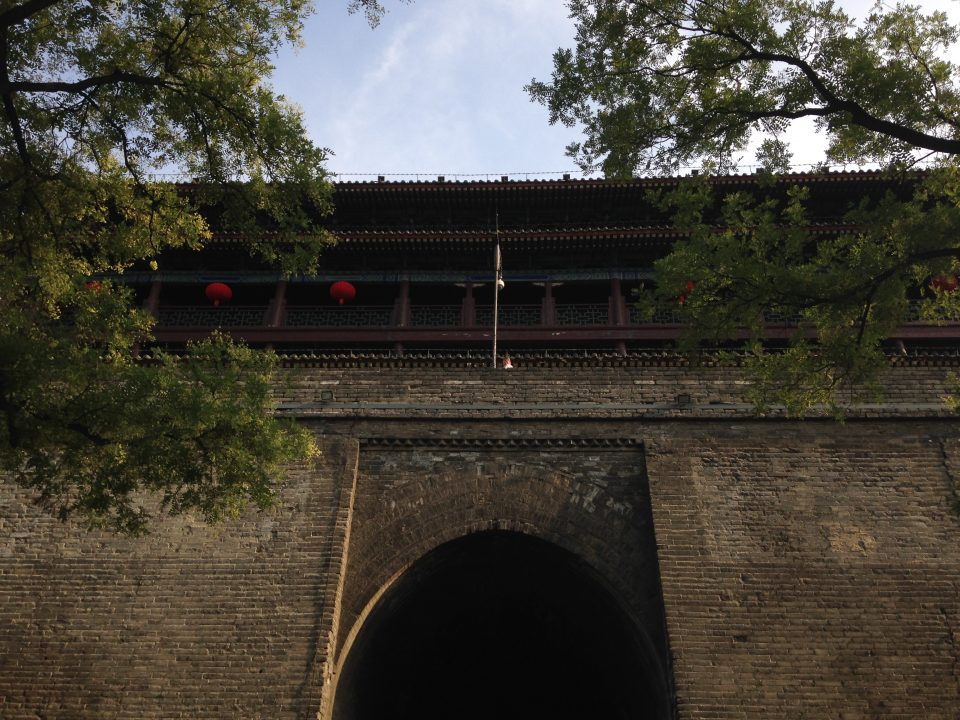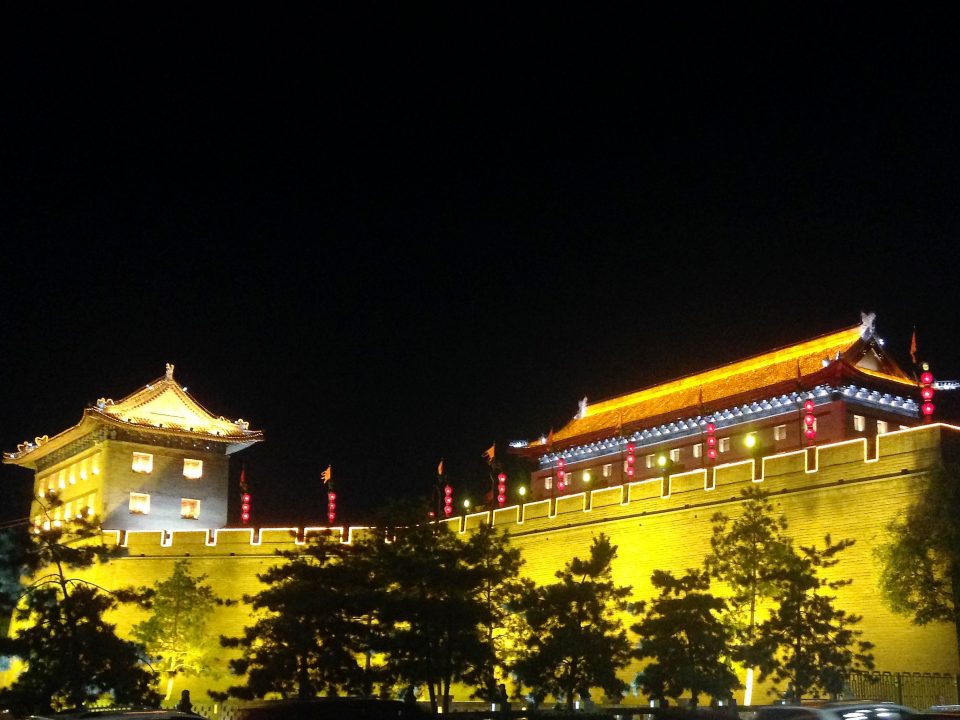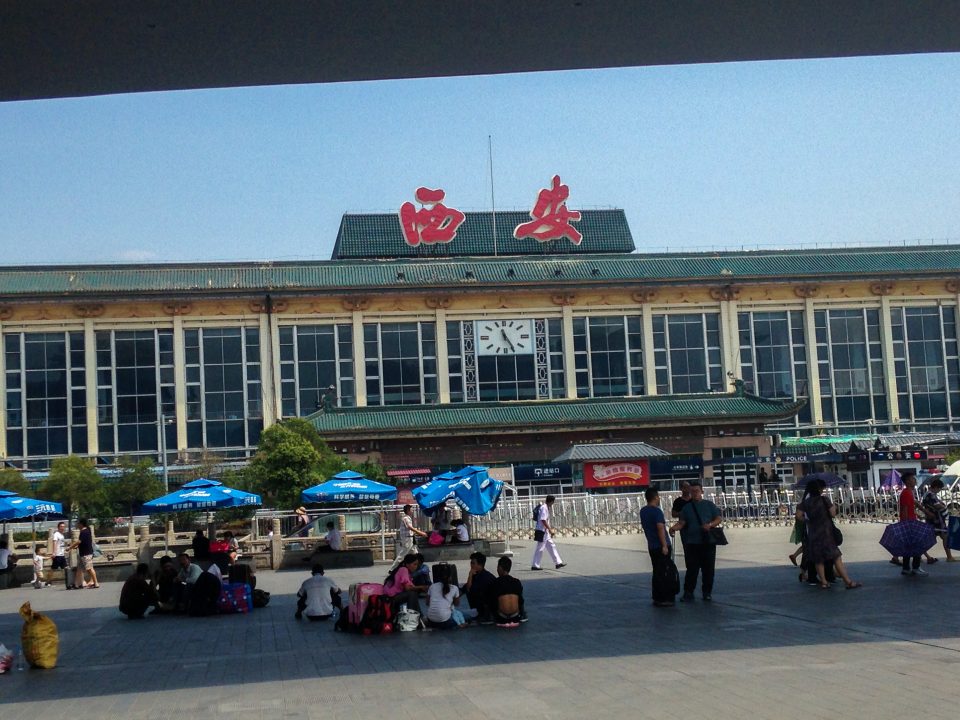The History of the Walled City of Xi’An
Published by CamDarling on
Xi’An is one of the most historic cities in China. The downtown core is a UNESCO world heritage site thanks to the giant ancient wall that stands as a reminder of the Empires that rose and fell beneath them. From the Qin Dynasty’s capital in Xianyang where China was first unified under one Emperor, to the golden age Tang Dynasty and their capital Chang’An. Xi’An is a city where worlds collided, cultures mixed and merchants traded from around the world. Today the city is one of the largest in China with 20 million people and the ancient walls are illuminated for everyone to enjoy.
The foods like Paomo and Biangbiang are a must for any tourist and the Belgian Bars offer imports for travelers missing the taste of fine beer. Take a day to check out the free Shaanxi History Museum and the Giant Wild Goose Pagoda, you won’t be disappointed.

History of Xi’An, The Ancient Walled City
In our last article about the First Emperor of China, Qin Shi Huang Di, we know that the Qin Dynasty was based in Xianyang in 206 BC just outside of modern day Xi’An. But let’s fast forward to the Tang Dynasty in 607 AD, over 800 years later.
Xiangyang was gone, the new city was an ancient version of Xi’An, known as Chang’An. The Tang Dynasty rose to power after the fall of the Sui Dynasty and became one of the world’s largest empires within the next 300 years. Between 618 and 907 AD, Xi’An was the most populous city in the world. The empire stretched from Northern Vietnam to the western region of modern day Tajikistan, to the border of Korean.

The Tang Dynasty is considered China’s golden age both in terms of culture and power. This power came from ruling over a population that was around 50 million in the 7th century, to eventually over 80 million by the 9th! And of course a very efficient trading network through the Silk Road that brought Chinese goods to the West in return for gold and precious gems. The Tang Dynasty was so powerful, they influenced Japanese & Korean politics.
We know from out Uji article that around the 8th century, Buddhist Monks made their way from China to Japan and introduced green tea, Buddhism and the Chinese style of architecture. The Tang Dynasty was the first to widely introduce a standardized scholars/officials examination for appointing new administrators to office. The Chinese State was highly bureaucratic but encouraged academia.
The Tang Dynasty built the smaller earth wall seen in the photo. They used a method of building that involved using weights to compact the earth until it was extremely dense. This wall is still inside today’s larger walls in the southern sections.

It would take another 400+ years before the Ming Dynasty would renovated and expand the walls in Xi’An in the 14th century. And again in the 16th century adding brick on the exterior walls and top.
This time Xi’An was rebuilt to be the capital of Shaanxi Province under the Ming Empire. The Ming were the last ethnic Han Chinese Imperial Dynasty in China.
At their height, they fielded a standing army of over 1 million men, the largest navy in the world and ruled out of Beijing. Under the Ming, the Forbidden City was built, the Great Wall of China was unified and fortified and encountered the trading vessels of the western powers of Portugal, Spain and the Dutch for the first time. Xi’An became less important compared to Beijing and Canton (Guangzhou) in the following centuries but through all that time, famine, revolution and, wars the walls of Xi’An have remained.
Despite being located in central China, Xi’An played a crucial role in the integration of Christianity in China. In 1625, a giant stone tablet dating back from the Tang Dynasty was discovered. The ancient writings documented 150 years of Christianity in China along the northern border towns. It also documents and proves contact between the Tang and the Eastern Roman Empire in 635 AD.

The Fall of the Tang came about in a very Roman way. Since the empire was so large, a professional army was used to conquer other territories and quell rebellions. But this required creating smaller regions in the empire governed by military legates (Jiedushi). Meanwhile the capital of Xi’An didn’t need an army as it was never directly involved in any fighting.
So these frontier regions ended up with Governors that often had over 100,000 trained veteran soldiers under their control. They rebelled against the Tang until they officially acknowledged the right of hereditary rule… meaning the governor’s position essentially became a kingship under the Emperor rather than an appointed position.
Now that each region was ruled almost independently, the Tang Emperor became more of a figurehead until the last one was deposed and then poisoned in 907. A very romanesque ending.
The Best Xi’An Foods
Biangbiang is my favorite food in China. The whole experience is just awesome from the little plastic chair restaurants, to the chefs kneading and shaping the noodles in the back.
The dish is basically a thick noodle dripped in oil, with meat, green onion, spices and chop suey. Eating a meal that is essentially one long endless noodle is hilariously fun. But what makes this my favorite menu item is the character in Chinese for ‘Biang’. The character has 58 strokes, making it one of the most intricate and complex characters for a noodle dish ever.
It’s so complex that most restaurants just print the letters ‘BiangBiang’, so it’s the only item on a local menu written in the English Alphabet!
Pao mo or ‘Paomo’ is a dish I regretfully missed eating in Xi’An. Which obviously means I need to return if only to try this famous lamb soup dish. The city of Xi’An has a prominent Muslim district where you can find traditionally Muslim foods, shops and mosques.
Since Xi’An was the end of the Silk Road, the population of Han Chinese decreases in favor of the Uyghurs & Mongolian minorities the more west you go. This makes Shaanxi a hub of cultures and great place to try local specialties.
Paomo is a hot stew of bread crumbs, lamb broth, green onion and lamb meat or beef (Beef Paomo). The soup is usually served with garlic and chili sauce.
The last dish I must recommend is Hot & Sour Beef Dumplings (酸汤水饺), a Xi’An style dumpling soup that will blow your taste buds away. This dish combines two of my favorites parts of Chinese cuisine: Dumplings and spicy broth.
You can get beef noodle soup all across China and each time will taste different thanks to the amazing broths. I’ll include a link to Tripadvisor for a famous dumpling house in Xi’An. But it should be pretty easy to find at most restaurants serving dumplings.
I found a recipe here so you can give it a try at home and then try the real thing in Xi’An. Dumplings are super fun to make at home and obviously taste delicious! The secret to the Xi’An soup is spicy vinegar, chili oil and Sichuan pepper.
Shaanxi Museum & Goose Padoga
The Shaanxi Museum is among the best in China. It’s an enormous 65,000 sq ft building that took 8 years to build from 1983 to 1991. The entrance fee is free but tickets are limited to 4,000 each day so going early s recommended. The museum houses over 370,00 relics from Chinese Dynasties.
Shaanxi Province was the center of power for several Chinese Dynasties over 1,100 years. The region is considered one of the cradles of Chinese civilization, and it’s capital Xi’An, one of the four great ancient capitals of China. The First Dynasty of unified China, whom we covered in our last article of Emperor Qin had their capital Xianyang just outside of modern day Xi’An.
The city was the last stop east on the Silk Road, so the relics found nearby could have originated from as far as France and Spain, or even the Mali Empire in Africa. The relics on display are proof of a very advanced ancient civilization with sophisticated art, bureaucracy, money based economy and craftsmanship of precious gems and fine silks.
Shaanxi Museum
- Hours: Tuesday to Sunday 8:30 am to 6:00 pm from March 16th to November 14th. Shorter winter hours of 9:00 am to 5:30 pm November 15 to March 15th.
- Fee: Free, 4,000 tickets available each day.
- Requirements: ID Card
- Services: Free deposit box for belongings. Audio Guide for Rent, Temporary Special Exhibits (Cost varies)
I slept in after visiting the Terracotta Army archaeological site outside of Xi’An the previous day. So I only made it to the museum around 1:00 pm. The summer in Xi’An is scalding hot so an afternoon in the air conditioned building was a welcome relief.
I was delighted to find the museum very spacious and not crowded at all. I got an up close look, undisturbed by mobs of people, at the Terracotta Warriors on display, the chariot excavation and countless relics of pottery, coins and little creepy statues, some dating back to the 9th century BC.
I recommend going in the morning and spending the day there and visiting the Giant Goose Pagoda nearby. Totally worth it!
Giant Wild Goose Pagoda
This Buddhist Pagoda is one I regret not visiting properly. I was traveling with my friend Ben who I met in Yangshuo. We decided to visit at night because we heard there was a fireworks display.
Long story short, we showed up late as the event was over. The huge crowd was already well on it’s way out of the large courtyard. We took some photos of the stone mural and pagoda then headede for some beers.
Here is what we missed: The Pagoda was built in 652 during the Tang Dynasty. It was originally five stories but then expanded over the next 900 years to ten stories until 1556 when an earthquake caused some major damage and the pagoda was reduced to seven stories, around 206 ft. high.
Tourists are welcome to climb the stairs to the top viewing platform and enjoy the amazing view of Xi’An. Note that’s a lot of stairs and it may be crowded.
Jano’s Backpackers
I spent three nights at Jano’s Backpackers hostel just inside the south western corner of the ancient wall in central Xi’An. The location is honestly 10/10. At $5 per night for a hostel bunk, it was a pretty great deal. Plus the bunk came with a free drink ticket at the next door Belgian Pub! Bonus!
The hostel staff were super friendly, fluent in English & Japanese and both Mandarin & Cantonese. The hostel is primarily in the basement of a few of the bars along this busy night life street. Being in the basement had its pros and cons. The temperature was quite pleasant even without air-con, but there were no windows and the whole place smelled a little damp.
The men’s showers were pretty bare bones, with just curtains separating the shower heads but it was big so I never had to wait in line. The dorm bunks were also fairly basic, but they had plugs for each bed which is all I need. The common room was big, spacious and comfy with lots of couches and places to sit down and relax after a long day walking around the city.
Next door to Jano’s is a Belgium themed bar that serves a large variety of Belgian, German and other European beers. Being from a country where the government regulates what beers are sold in stores and in bars, I was very excited!
The prices are western, but still decent considering that there are so few bars with great quality beer in China. After two weeks of drinking the local rice beers that sell for 0.30 to 0.50 cents in stores, splurging on a refreshing beverage felt great!
The bars in Xi’An always have live musicians playing covers of famous English, Chinese and even Korean songs!
Xi’An days in the summer are hot, so the best time to walk around is late at night when it’s nice and cool out. So only after sun down Xi’An has a great music scene. Walking around the city late at night, it’s easy to find musicians playing on the street corners. They bring their own mics & speakers. Often there are several musicians in a row all putting on performances at the same time. The locals and tourists alike just enjoy the cool night atmosphere and live music,
Getting Around Xi’An
Xi’An has a great subway line that runs directly through the middle of the inner city (part inside the wall). It’s the red line or line No. 2.
The confusing part is that there are three main railway stations in the city. The North Railway Station, South Railway Station, and the Xi’An Railway Station. Xi’An is a huge city, so try and book a train to Xi’An that ends at the regular Xi’An Railway Station. It’s located on the North-East corner of the Wall surrounding downtown and has a bus terminal for easy connections.
If you’ve read our 5 Best Apps for China, you should already have a good subway system app for all the Chinese cities. They make navigating all the subway lines super easy! I’ll include links to the Androind and iOS versions.
My time spent in Xi’An was short and hot. It was my first time in 40+ degree temperature! Carry lots of water in the summer, or a big jacket in the winter. The city has so much to offer tourists with dozens of museums, night clubs, temples, mosques and amazing foods. I’m positive I’ll return to Xi’An again one day, maybe to retrace the Silk Road into western China. One day!
Traveling in China can be a challenge due to the language barrier and internet censorship. Check out the Best VPNs for China so you can use Google Maps, Instagram and Facebook. And consider pick up a SIM Card for cheap to share all those awesome moments live with friends.
If you haven’t read our article on the Qin Dynasty, it’s a great introduction to the Terracotta Warriors in Xi’An. We also provide instructions on how to get there yourself using local transit.






























